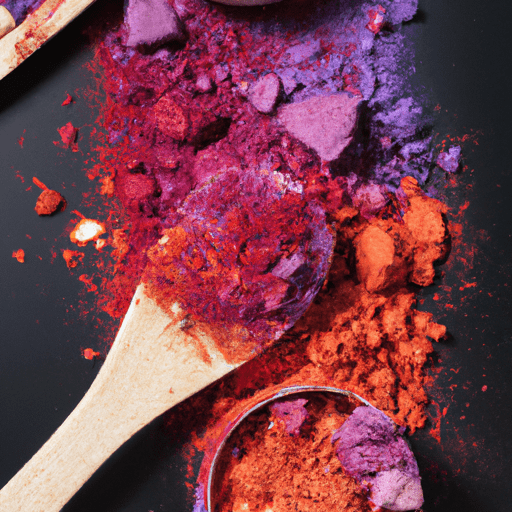Exploring the World of Food Colors
Food is not only a source of sustenance but also a feast for the eyes. One factor that contributes to the visual appeal of a dish is the vibrant array of colors that grace our plates. Whether it’s the deep red of a ripe tomato or the vibrant green of fresh spinach, colors in food can enhance our culinary experience. Let’s dive into the fascinating world of food colors and discover their taste, uses, nutritional value, and some interesting facts.
Taste and Sensory Delights
Food colors not only affect our visual senses but can also influence our perception of taste. Studies have shown that the color of food can affect our expectations and taste preferences. For instance, the rich, golden hue of a buttery croissant can evoke feelings of warmth and pleasure, even before taking a bite. Similarly, vibrant shades of red and orange in a bowl of fresh fruits can increase our appetite by signaling their sweet and juicy flavors.
Common Uses in Cooking
Food colors are widely used in the culinary world to enhance the visual appeal of dishes. They provide a delightful burst of color and can transform a simple meal into an eye-catching masterpiece. Here are some common uses in cooking:
Baking: Food colors are popularly used in baking to create vivid cakes, cookies, and pastries. From pastel hues to bold and vibrant shades, food colors can turn a plain-looking dessert into a work of art.
Sauces and Condiments: Adding a touch of color to sauces and condiments can make them more visually appealing. A vibrant green pesto or a deep red tomato sauce not only adds flavor but also makes the dish visually enticing.
Decorative Elements: Food colors are great for adding decorative touches to dishes. Whether it’s marbling effects on icing, rainbow-colored sprinkles on cupcakes, or creating intricate patterns on cookies, food colors allow chefs and home cooks to unleash their creativity.
Nutritional Value
Food colors are derived from both natural and artificial sources. Natural color additives are typically derived from fruits, vegetables, and other plant-based sources. They often contain additional nutritional benefits, such as vitamins, minerals, and antioxidants. On the other hand, artificial food colors are chemically synthesized and do not provide any nutritional value.
It’s worth noting that while natural food colors can have nutritional benefits, they should still be consumed in moderation. Eating a well-balanced diet rich in a variety of fruits and vegetables is the best way to ensure a vibrant and healthy plate.
History and Fun Facts
Ancient civilizations, such as the Egyptians and the Chinese, used natural food dyes to enhance the visual appeal of their dishes. For example, they used saffron to create a vibrant yellow color in their foods and beverages.
In the late 19th century, food coloring became widely accessible with the invention of synthetic dyes. This revolutionized the food industry, allowing for a more extensive range of vibrant colors in processed foods.
Some natural food dyes have been used for medicinal purposes throughout history. For instance, beetroot powder was used by ancient Romans as a treatment for constipation and fever.
The wide range of food colors available today allows us to explore creative and visually impressive culinary creations. From natural options like turmeric and spirulina to artificial dyes, the possibilities are endless.
In conclusion, food colors play a significant role in our culinary experiences. From enhancing the visual appeal of dishes to influencing our perception of taste, they add a vibrant and artistic dimension to our meals. While moderation is key, experimenting with food colors can open up a world of creativity and delight for both professional chefs and home cooks alike. So next time you step into the kitchen, don’t be afraid to bring a splash of color to your culinary canvas. Happy cooking!
*[AI]: Artificial Intelligence
Food Colors
Here are some interesting facts about food colors:
Origin: Food colors are substances used to enhance the appearance of food and beverages. They can be derived from natural sources or synthetically made.
Common Uses: Food colors are widely used in the food industry to make products visually appealing and attractive. They are used in a variety of food and beverage products, including candies, cakes, beverages, desserts, and processed foods.
Types of Food Colors: There are two main types of food colors: natural and synthetic. Natural food colors are derived from plant, animal, or mineral sources, while synthetic food colors are chemically manufactured.
Nutritional Benefits: Food colors do not provide significant nutritional benefits. Their purpose is primarily for visual appeal rather than adding nutritional value to the food.
Coloring Agents: Common natural coloring agents include beet juice, turmeric, spirulina, and caramel. Synthetic food colors include Tartrazine (Yellow 5), Red 40, and Blue 1.
Regulation and Safety: Food colors are regulated by food safety authorities in many countries. They undergo rigorous testing to ensure their safety and often have strict usage limits. Some individuals may have sensitivities or allergies to certain food colors.
Unique Properties: Food colors can add vibrancy and variety to different food products. They can be used to create specific visual effects, such as making a product appear more appetizing or mimicking the appearance of natural ingredients.
Historical Significance: Throughout history, humans have used natural food coloring agents, such as saffron and beet juice, to add color to food and beverages. The use of synthetic food colors became more prevalent in the early 20th century due to their stability and affordability.
Remember that the usage of food colors varies between countries, and it’s important to follow any regulations or guidelines in place when using them in food preparation.




Use the share button below if you liked it.
It makes me smile, when I see it.